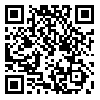Volume 10, Issue 1 (Spring 2023)
johe 2023, 10(1): 1-8 |
Back to browse issues page
Download citation:
BibTeX | RIS | EndNote | Medlars | ProCite | Reference Manager | RefWorks
Send citation to:



BibTeX | RIS | EndNote | Medlars | ProCite | Reference Manager | RefWorks
Send citation to:
Hosseini S E, Aliabadi M, Golmohammadi R, Shafiee Motlagh M. Experimental Study of the Sound Emission Pattern Based on Acoustic Characteristics in Typical Industrial Manufactories in Hamadan, Iran. johe 2023; 10 (1) : 1
URL: http://johe.umsha.ac.ir/article-1-840-en.html
URL: http://johe.umsha.ac.ir/article-1-840-en.html
1- Department of Occupational Health, Occupational Health and Safety Research Center, Hamadan University of Medical Sciences, Hamadan, Iran
2- Center of Excellence for Occupational Health, Occupational Health and Safety Research Center, Hamadan University of Medical Sciences, Hamadan, Iran ,aliabadi@umsha.ac.ir
3- Center of Excellence for Occupational Health, Research Center for Health Sciences, Hamadan University of Medical Sciences, Hamadan, Iran
4- Center of Excellence for Occupational Health, Occupational Health and Safety Research Center, Hamadan University of Medical Sciences, Hamadan, Iran
2- Center of Excellence for Occupational Health, Occupational Health and Safety Research Center, Hamadan University of Medical Sciences, Hamadan, Iran ,
3- Center of Excellence for Occupational Health, Research Center for Health Sciences, Hamadan University of Medical Sciences, Hamadan, Iran
4- Center of Excellence for Occupational Health, Occupational Health and Safety Research Center, Hamadan University of Medical Sciences, Hamadan, Iran
Abstract: (3877 Views)
Background and Objective: Noise pollution inside buildings is caused by frequent sound reflection from their inner surfaces. The purpose of this study is to experimentally study the sound emission pattern based on acoustic characteristics in typical industrial manufactories.
Materials and Methods: This study was conducted in rectangular cubic manufactories with a volume of less than 2000 m2, between 2000 to 3000, and 3000 to 4000. The space reverberation time was measured according to the ISO 3382-2-2008 standard, and the sound emission pattern in manufactories was performed according to the ISO 11690 standard. The space sound level was measured based on the distance from the source with pink noise. In order to simulate sound parameters, the radiation tracking method was used in Odeon. Data analysis was conducted using the SPSS software.
Results: The average reverberation time in manufactories under 2000, between 2000-3000, and between 3000-4000 m2 was 1.75, 2.25, and 2.77 sec, respectively. The measured reverberation time had a significant correlation with the predicted reverberation time (r=0.95, P=0.05). The average sound reduction based on the distance from the source was 4, 3, and 3 dB in manufactories under 2000, between 2000-3000, and between 3000-4000 m2, respectively. There was also a negative significant correlation between the sound reduction level and the reverberation time (r=-0.97, P=0.05). The correlation between the measured and predicted sound levels was determined (r=0.95).
Conclusion: Reverberation time calculated by Sabin and Eyring’s formula showed higher values than those of the measurement method. There was also a significant relationship between the average sound reduction pattern and the average time of vocalization. Therefore, measuring sound reduction based on the distance from the artificial source can be used to show the sound emission pattern, even on its own, due to the simplicity of the measurement method. It is recommended to be used with the reverberation time to evaluate the sound emission pattern in manufactories.
Materials and Methods: This study was conducted in rectangular cubic manufactories with a volume of less than 2000 m2, between 2000 to 3000, and 3000 to 4000. The space reverberation time was measured according to the ISO 3382-2-2008 standard, and the sound emission pattern in manufactories was performed according to the ISO 11690 standard. The space sound level was measured based on the distance from the source with pink noise. In order to simulate sound parameters, the radiation tracking method was used in Odeon. Data analysis was conducted using the SPSS software.
Results: The average reverberation time in manufactories under 2000, between 2000-3000, and between 3000-4000 m2 was 1.75, 2.25, and 2.77 sec, respectively. The measured reverberation time had a significant correlation with the predicted reverberation time (r=0.95, P=0.05). The average sound reduction based on the distance from the source was 4, 3, and 3 dB in manufactories under 2000, between 2000-3000, and between 3000-4000 m2, respectively. There was also a negative significant correlation between the sound reduction level and the reverberation time (r=-0.97, P=0.05). The correlation between the measured and predicted sound levels was determined (r=0.95).
Conclusion: Reverberation time calculated by Sabin and Eyring’s formula showed higher values than those of the measurement method. There was also a significant relationship between the average sound reduction pattern and the average time of vocalization. Therefore, measuring sound reduction based on the distance from the artificial source can be used to show the sound emission pattern, even on its own, due to the simplicity of the measurement method. It is recommended to be used with the reverberation time to evaluate the sound emission pattern in manufactories.
Article number: 1
Type of Study: Research Article |
Subject:
Physical agents
Extended Abstract [HTML 18 KB] (249 Download)
Send email to the article author
| Rights and permissions | |
 |
This work is licensed under a Creative Commons Attribution-NonCommercial 4.0 International License. |







